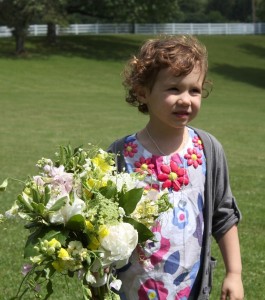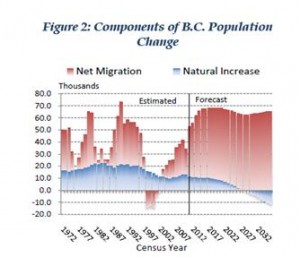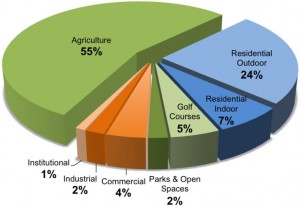“Do not compute the totality of your poultry population until all the manifestations of incubation have been entirely completed.” – William Jennings Bryan
I’m calling 2012 “the year of weddings and babies” – there are dozens popping up on my facebook. It’s also the year of the dragon, and my friend from China says many couples purposely plan and wait to have “dragon babies.” There’s a feeling of exuberance in the air.
And so, with celebration, the population grows. Much has been written about global carrying capacity, but we are human, here and now.
Where will everyone live? Some are moving here – BC Stats says 45% more for the Central Okanagan by 2036 – maybe 70,000 or 80,000 new people. Other regional districts may grow more slowly, but this seems like a good proxy for growth up and down the urban core of the valley.
It’s a beautiful place to be. We actively try to attract young families and workers; and the retirees come with little coaxing. It’s part of a great global migration.
And what about the water? This year there is no lack of rain, but it always pays to be thoughtful about essential resources. As we have more people, we’ll need more clean drinking water, and more fresh fruit and vegetables.We’ll have more neighbours to feel the effects of floods and shortages, and more of us will be out hiking and biking in the watershed. We’ll have bigger demands for lumber and gravel, more boats on the lake, more everything.
Being a great lover of babies and weddings – reconciled to a world with more people in it – the big question is how to accommodate everyone comfortably.
In the next 30 years, all the new neighbours will probably change our communities and influence water even more than climate change. It really matters where and how you live, work and play on the land.
Planning, as they say, is best done in advance – even at risk of counting one’s chickens before they hatch – but how to plan for an uncertain future? Scenarios are the stories that we tell when we’d like an educated guess.
In our first study, we assumed communities would grow steadily at 1% per year, mostly by infill – staying within existing footprints, and everyon living closer together. Adding more people didn’t have a big effect on water, because most residential water is used on lawns. As cities get dense, lawns get smaller.
After these results came in, we had a nagging feeling they weren’t very realistic. Between 1987 and now, the population of the Central Okanagan has grown rapidly at 2.9% per year. There are lots of developments already in the pipeline – some infill, and some built-out to new areas.
Right now, lawns and landscaping use 25% of the water. Outdoor water use is consumptive: taken up by plants and evaporated – lost to the system. Adding more lawns has to make a difference.
What would happen if all the new houses were like the old ones – same size lots, same size lawns? What if the population kept growing fast (2.5% per year)? We called the team back together and rolled out more scenarios.
The first thing is that we ran out of places to put people.
We had to push developments up the hillsides, watering lawns in new areas that had never seen irrigation. We stayed off the Agricultural Land Reserve (ALR), and put the houses wherever we could, avoiding steep slopes.
The effect on water was impressive. Summer water use shot up by 20-30%, more than if we watered every bit of remaining un-irrigated agricultural land and all the First Nations lands. Water conservation (at current rates), only brought this down by about 5%.
Climate change didn’t show a huge effect on total precipitation between now and 2040, but just intensified all the possible risks of floods and shortages: less snow-pack storage; early, more powerful freshet; longer, hotter summers; more intense swings between dry and wet years.
It does seem smart to be dense – and bringing more people into downtown Vernon, Kelowna, and Penticton has benefits ranging from less traffic to lower costs. But that isn’t the only option. I’m not a huge fan of urban growth boundaries after seeing California home prices shoot up, and low-income workers having to commute in from outlying areas.
That being said, protecting the agricultural lands and our food-growing capacity will be important with new people to feed and even weirder weather elsewhere.
In the end, the biggest reservoir we have is our discretionary outdoor water use. Having more people in the valley will bring plenty of challenges to plan around, but from the water end of things, it’s not the houses that are the problem, or the agriculture – it’s the lawns and the run-off.
If lawn watering is cut in half, instead of increasing, there’s easily room for many more young families, grandparents, babies and weddings and an excellent quality of life. People might like not having to mow as much.
There are many other smart things to do for run-off in wet years – protecting water sources, setting back houses from streams and lake shores, restoring wetlands and riparian areas to reduce flooding and erosion. I’ll write more about that soon.
“The rain it falls on everyone, both just and unjust fellows; but mostly on the just, because the unjust have the just’s umbrellas.”







I remembered the rhyme about the umbrella slightly differently so I googled it, and came up with this bit of enlightenment:
(The) 1959 edition of Simon and Schuster’s (sixth printing) of The Fireside Book of Humorous Poetry (edited by William Cole) credits Lord Bowen for the ditty. It reads exactly:
The rain it raineth on the just
And also on the unjust fella;
But chiefly on the just, because
The unjust steals the just’s umbrella.
– Lord Bowen
Thanks, Julian! It’s a bit tangential to the topic at hand, but the weather this spring keeps umbrellas at the front of mind.
I too have weddings on my mind. My first born son will be married this summer. Which then leads to thinking about rain, lawns, gardens, soils…and then to climate variation. Floods, drought, forest fires bring loss of another valuable and ever dwindling resource – soil. If we increase density and move further into vegetated areas to accommodate that growth we should think about two things. 1) How many times can we re-use that water? and 2) What can we do to protect that soil? Larger populations will have to ensure that we wash our dishes, water our lawns, and grow our vegetables all with that same tablespoon of water. Building up the hillsides means we must capture the runoff in swales and natural contours that keep soil in place. Yes, the planning season is upon us!
Thank you, Kathy. Congratulations on your expanding family. It is always great to have you contribute.
Pingback: Mud-bogging and other ways we love the land too hard | | Building BridgesBuilding Bridges
Pingback: Getting beyond inertia and disaster-driven policy response | | Building BridgesBuilding Bridges
Pingback: The Value of Water | | Building BridgesBuilding Bridges
Pingback: Lessons from Sandy: disaster isn’t our only option | | Building BridgesBuilding Bridges
Pingback: Water Day, every day | | Building BridgesBuilding Bridges